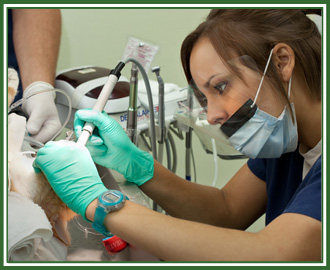DENTAL ORAL SURGERY AND PROFESSIONAL CLEANING
 Just like people, our pets’ teeth ideally should be professionally scaled and polished regularly. This procedure not only cleans off the obvious brown tartar that you can see but more importantly it cleans underneath the gum line. Scaling underneath the gums reduces painful gingivitis (swollen and painful gums) and helps the diseased gums heal, and reduces worsening of gum recession.
Just like people, our pets’ teeth ideally should be professionally scaled and polished regularly. This procedure not only cleans off the obvious brown tartar that you can see but more importantly it cleans underneath the gum line. Scaling underneath the gums reduces painful gingivitis (swollen and painful gums) and helps the diseased gums heal, and reduces worsening of gum recession.
A common question we get is why pets need to be under general anesthesia for dental cleaning.
The answer is fairly simple: in order to scale and polish all of their teeth at all angles, especially scaling under the gum line, it is simply impossible to do properly with the pet awake. Unlike a person in a dental chair, we cannot reason with the pet as to why they need to keep completely still while we put an instrument in their mouth and perform a procedure for a significant period of time that may be uncomfortable for them. Physical restraint is not an option. Even if it was possible, it would require several skilled restrainers and be extremely stressful for your pet and it still would be unlikely that each tooth could be properly cleaned and graded and scaling under the gum line could be done properly. It is also important that they are intubated (a breathing tube attached to an oxygen/anesthethic machine) so they cannot aspirate any fluid into their lungs during the procedure.
Some people have a fear of general anesthesia. At your pet’s next annual exam (or any time your pet is in), we encourage you to talk to the veterinarian and/or technicians about precautions and safety procedures we have in place as well as specific concerns you may have about your pet. It is important to remember that the risk for anesthesia for young healthy pets is very low.
PET DENTAL EXTRACTIONS
It is a common concern that a pet will need many teeth extracted.
I will never forget an older gentleman that brought in his dog for an exam. Afeter I examined his dog I discussed with him that some of the teeth were very infected and needed to be extracted. I was well aware that a lot of people don’t like the thought of their pet’s teeth being removed. To my surprise, the gentleman said to me, “Doc, do what you need to do. I had all of my teeth taken out two years ago, and I only wish that I had done that years earlier! They were causing me so much pain.”
As much as we would like to always see teeth that only require cleaning, many times we do come across ones that are beyond salvageable. When a tooth is infected and painful, the best option for the pet is to have it removed.
Will your pet still be able to eat with some of their teeth gone? The answer is, absolutely. In the wild, their ancestors needed their teeth to tear away meat. In captivity with our kibble and canned food pets really do not even need ANY of their teeth to be able to eat their food.

I hope this has answered some of your questions and busted some common myths about our pets’ oral health. If you have any further questions, please feel free to give us a call!
Dr. Lilla Yan